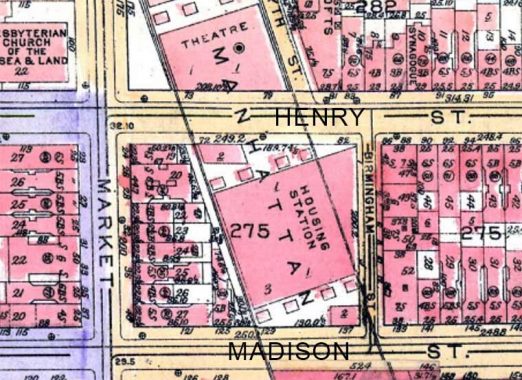
TUCKED away beside the Manhattan Bridge, predating it by a century or more, was a one-lane alley called Birmingham Street, running between Henry and Madison Street east of Market Street. When the mighty Manhattan was built from 1903-1909, it was shadowed for about the next sixty years before it was unceremoniously eliminated. Here’s what you’ll find there now.

This map from 1924 indicated Birmingham Street clearly. Interestingly there had been a theater beneath the Manhattan Bridge on Henry Street. The spot corresponds to what would be 75-79 Henry, but unfortunately, it doesn’t turn up in the Municipal Archives Henry Street photo collection.

However there are a few Birmingham Street photos, and this one is the best. As you can see there were 4 or 5 tenements buildings on this skinny block, but it must have been dark indeed as I cannot spot a lamppost.

According to the essential Gil Tauber, Birmingham Street had been eliminated by 1962 and it leaves no trace. In fact by 1950 it had been renamed Livingston Place, for no reason I can discern. This is what the former intersection looks like at Madison Street…

…and at Henry; across the street is the south end of Forsyth Street, which forms the right side of Sara D. Roosevelt Park for most of its run.

I’m not sure if Birmingham Street ever received a 1960s-era Manhattan gold and black street sign, so I’ll run one up here. Sick transit, Gloria!
As always, “comment…as you see fit.” I earn a small payment when you click on any ad on the site.
5/11/22


2 comments
That appears to be the location of the Florence Theater, built around 1920, which later became the Sun Sing Movie Theater. The building is directly under the Manhattan Bridge and photos of the Sun Sing are plentiful online.
A few notes of interest: the March 3, 1949 edition of the Times notes that there was a live poultry market at #6 Birmingham Street, which was badly affected by a four alarm fire which swept through the four upper floors of the seven story loft building; the January 31, 1896 edition of the Times notes on its front page the story of a safe robbery that took place at ##2 and 4 Birmingham Street. The June 24, 1954 edition of the Times has an interesting discussion of an attempt to restore the name of Livingston Place to an area that had been re-designated Nathan D. Perlman Place; however, the March 28, 1954 edition of the Times seems to indicate that Livingston Place was at 15th to 17th Streets between 1st and Second Avenue. My 1947 Hagstrom’s Atlas shows both Birmingham Street and Livingston Place on Map No. 1, widely separated. The February 3, 2013 edition of The New Yorker carries a pungent description of Birmingham Street by no less than Joseph Mitchell: “…Birmingham Street, which is a tunnel-like alley that runs for one block alongside the Manhattan end of the Manhattan Bridge and is used by bums of the kind that Bellevue psychiatrists call loner winos as a place in which to sit in comparative seclusion and drink and doze and by drug addicts and drug pushers as a place in which to come into contact with each other and by old-timers in the neighborhood as a shortcut between Henry Street and the streets to the south…” https://nyhistorywalks.wordpress.com/tag/two-bridges/ has a note that the Florence Theater (referred to in a previous comment) was built in 1911 and showed Yiddish vaudeville and motion pictures, but in 1942 became the New Canton Theater and showed Peking opera, especially by a troupe stranded by World War II; LIFE Magazine apparently profiled the theater in its May 1, 1950 issue. It became the Sun Sing Theater in 1950, and according to https://wikimili.com/en/East_Broadway_%28Manhattan%29 closed in 1993. The latter URL gives its address as 75-85 East Broadway; 75 East Broadway is the address for the Sun Sing Theater given in a September 16, 1953 movie review in the Times. The March 8, 1998 edition of the Times has a timeline history of the theater, tied to proposed redevelopment of the then-vacant parcel.